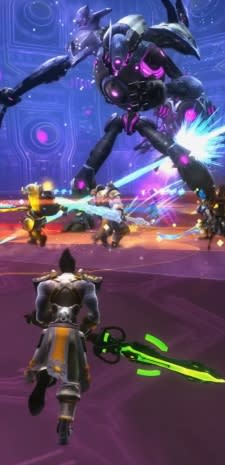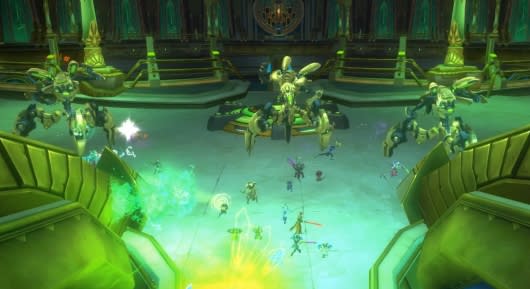WildStar unveils the details of raids
WildStar wants to have its raids be big. Big in size. Big in rewards. Big in engagement. Big in lots of ways, in short. The team has talked about them in passing elsewhere, most notably at PAX East 2014, but there still hasn't been a nice big info drop about raids that potential players could really sink their teeth into. Like the sort of reveal that accompanies a new DevSpeak video.
So guess what's past the cut? Go ahead, guess.
Very good, it's the raiding video (something you could have concluded from the headline, yes), but there's more besides. We had a chance to sit down and talk with Brett Scheinert, the dungeon & raid lead developer, regarding these high-end encounters and what will set WildStar apart from other titles offering a raiding endgame. And despite what those opening lines might have made you think, it's not just about size. (It's also Spinal Tap references. You can guess which ones.)
So how do you design a 40-person endgame raid? As Scheinert puts it, one of the keys is making sure that everyone has something interesting to do while at the same time not splitting everything down into niggling micromanagement. Every role needs to have something interesting to do and everyone should have a reason and a need to contribute; you don't want to have a raid group consisting of a dozen people working hard and another 30 or so standing around and waiting.
One of the ways that this is pushed by the game is by having different rooms behave differently; in some rooms, for instance, players will be splitting the raid into several smaller groups to handle individual objectives, while at other times everyone remains grouped up and active. It's also important to give the feeling that the team is contributing as a whole to the overall success, something that the game's interrupt armor helps to accomplish -- a coordinated effort will allow a team to interrupt a boss simply by piling on those stuns and interrupt effects.
At the same time, the team doesn't want raiding to be an exercise where one death means that the fight is already over. Obviously, world-first groups trying for a kill while somewhat undergeared won't be able to handle losing many people, but even the most punishing fights have some leeway built in for a few deaths. As the group gets more gear, it gets easier and there's more margin for error.
Speaking of gear, if you were hoping for a distribution system that was on the personal side of the spectrum, you're in for disappointment; bosses will drop a certain number of items and players will need to distribute them as the raid sees fit, same as it's ever been. There is, however, a fair amount of loot that comes from each boss. 3-4 pieces drop per boss in the 20-person raid, 6-8 drop in the 40-person raid, and every boss has challenges that drop loot, rooms along the way drop loot, and so forth. The math should work out to about 1-2 items per player per full clear without doing any of the challenges.
What about catch-up mechanics for players coming into the game later, with further tiers of raiding available? That's still to be decided. Scheinert stressed that the addition of new abilities and AMP tiers will make players more powerful compared to older raids even without a way to catch up in gear terms, which might make the older content far easier to blow through; at the same time, it's something that the team is keeping a close eye on. The key idea is that additional content should build on what's already there rather than replacing it.
Meanwhile, if you're clearing things on farm right from the word go, there's still meant to be stuff to chase. Challenges, for example, are available throughout the raid to provide extra loot. That loot is important, too, as the items that drop are slightly randomized; you don't know what the runeslots on a given item will look like until it drops, which means that you could get a chestpiece two runs in a row while still having it be a notable upgrade.
How long will it take to fully clear these raids? Genetic Archives is probably going to run about 3-5 hours, while Datascape is closer to 4-6 hours. Obviously, the raids are on a weekly lockout, and those estimates are based on full clears with groups geared enough to handle it rather than early learning runs. Meanwhile, the team is already looking toward the next tier of raiding; the goal is that as players exhaust the current tier, the next one will be ready.
Players will also be able to pick up a few more items from raids including Warplot boss tokens, mount customizations, and similar customization areas. Currently, raids don't drop anything specific for tradeskills, but that's still something that's up in the air for future implementation.
As for classes, the game's raiding seems to be in a good place now with all six classes having roughly equal representation on the field; stacking a raid with one class or another doesn't seem to be providing any advantage. The nature of the action sets contributes to this, as well; between encounters, players can swap abilities around to suit the needs of any given encounter.
Speaking of encounters, we closed by asking about Scheinert's personal favorite encounter in the current raid game. Rather than picking out a boss as his favorite, he actually chose a room, the Volatile Lattice encounter. Players have to split up and work hard to survive, dealing with the constant threat of death -- but there's no boss in the room. It's just a matter of player coordination and strategy on the level of a boss fight but without a big pile of hit points to chew through.
If you're not one for raiding, you may not be taken by WildStar's raids. But the developers seem very devoted to ensuring that if you do like your raiding, you'll have a fun time taking part in WildStar's version.
When readers want the scoop on a launch or a patch (or even a brewing fiasco), Massively goes right to the source to interview the developers themselves. Be they John Smedley or Chris Roberts or anyone in between, we ask the devs the hard questions. Of course, whether they tell us the truth or not is up to them!





